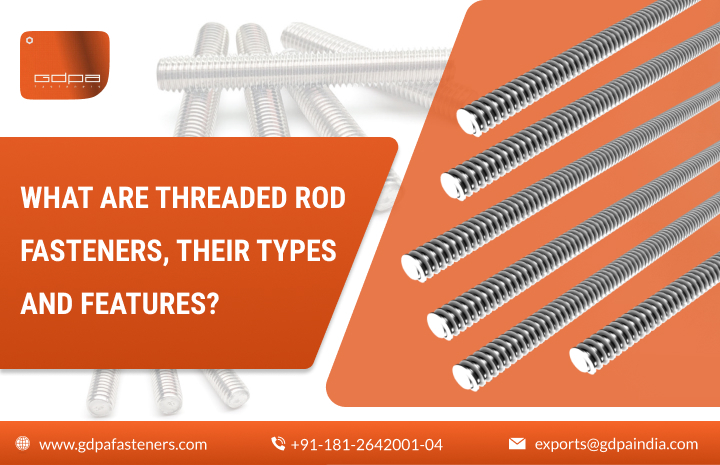
If you have already used nuts, bolts, and screws, then you may be aware of threaded rod fasteners. If you are a beginner and don’t know about these types of fasteners, then you must read this blog. In today’s blog, we will share information on threaded bars, their different types along with their characteristics. Despite this, you will also come to know how to use them in the right way without damaging the object. Let’s get started:
What is Threaded Rod?
To put it simply, a threaded rod is a long-length metal rod, and it has thread patterns from end to end. Threaded bars are available in different sizes, types, and materials. It is one of the most versatile fasteners available for fastening objects together. Basically, it is used to fasten metal or wooden objects together. In addition to this, they can be put into concrete or wood to enhance stability. They are used in various applications and can be found in numerous industries.
What is a Threaded Steel Rod Called?
A threaded steel rod is also known as an all thread, threaded bar, threaded stud or studbars. These are suited for suspending objects or items from ceilings and roofs. The larger sizes of threaded bars are used with nuts and washers on each end to create more stability.
What is a Threaded Rod Used for?
Threaded rod fasteners are used in industries where corrosive conditions are the problem and other areas where a high level of humidity is involved. Lengths of all threads are used where cleanliness is required, such as in the contractor or plumbing field. Other types of threaded bars are used within medical and machinery industries because of their anti-corrosive nature. Steel and stainless steel threaded bars are most commonly used because it is affordable and clean to install.
What are Threaded Rod Types and Features?
Threaded studs are of different types, and they have several features and functions. Some of the more widely used threaded bars varieties include:
-
Fully Threaded Rods
As the name implies, fully threaded rods have a full thread pattern from top to bottom. These types of threaded bars are perfect for applications where high strength and grip are required. To align body panels of vehicles, these threaded rods are used. If there is loosening resistance is required, then these fully threaded bars are appropriate.
-
Partially Threaded Rods
As the name suggests, these types of rods have partial thread patterns that commence from the bottom of the stud length. The grip length is the part where there is no thread pattern. Grip length may vary as per the intended application for the rod. These types of rods are most commonly used in pumps, motors, alternators, etc.
How to Choose a Threaded Rod?
As you know there are various types of threaded rods available on the market that will match your different conditions, purposes, and materials. Try to avoid using any type of threaded bars without knowing the purpose. It is suggested to choose the fully threaded bar if there is a need for grip strength. You should choose partially threaded bars if there is a requirement for alignment and shear resistance.
How to Use Threaded Rod?
Threaded bars are easy to use if you have already worked with bolts and screws. They work similarly to standard bolts with a few differences. Most bolts are threaded at one end, but the threaded bar has a thread pattern along its full length or at both ends. Various threaded rods manufacturers deliver a variety of threaded bars and you need to use them accurately. These are used as a pin to connect two items or objects together.
Advantages of Using Threaded Bars
There are various benefits of using the threaded rod as written below:
- These tools are used in different fields, such as agriculture, electrical, and construction.
- They have gained popularity because when you use them, then you don’t require using raw material. And, you also don’t need a threading tool. They are rolled under high force and it gives them high strength and durability. They are used with nuts and washers.
- To cut these rods, you can use a power band saw or metal cutting hack saw. The nuts can be rotated easily because of their thread patterns.
- These rods are most commonly used in the plumbing field.
What are the Sizes of Threaded Rod?
| Product Range | Specifications | Grade | Thread | Dimensional Range |
| Threaded Rods | DIN 975 | GR – 4.6/4.8/5.6/5.8/6.8/8.8/10.9 | METRIC 6G,8G | M6 TO M64 |
| DIN 976-A | GR – 4.6/4.8/5.6/5.8/6.8/8.8/10.9 | UNC/UNF-2A | L 1/2″ TO 21./2″ | |
| Engineered Stud Part/Fully Threaded | AMERICAN SERIES | GR – ASTM A193, B7 | UNC/UNF-2A | 1/2″ TO 2.1/4″ |
| DIN 975 | GR – 4.6/4.8/5.6/5.8/6.8/8.8 | METRIC 6G,8G | M6 TO M52 | |
| DIN 976-A | GR – 4.6/4.8/5.6/5.8/6.8/8.8 | METRIC 6G,8G | M6 TO M52 |
Conclusion
You can get in-depth detail about threaded rods, their types, features and different sizes from this blog. When buying threaded bars, make sure to know the purpose and then choose the right rod for the applications to prevent damage.